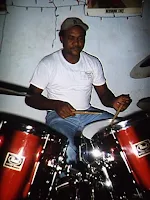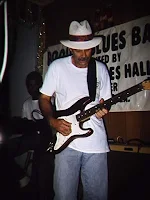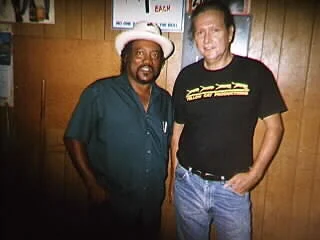Here's most of the band on the Last Friday Blues Jam in January, 1998. From left to right you see Luke Brouillette (pronounced "Brew-yet") on guitar, James Wagley on bass, Pop Hid-In-A-Corner Hymes on drums, Hardrick Rivers on sax, James Lee on keyboards, Rick Seale on guitar and James "Bubba" Prudhomme on guitar.
Rick and Bubba both work at the replication of Fort St. Jean Baptiste, a fort built in Natchitoches by the French way back in 1722. Maybe next blues jam Rick and Bubba will wear their 1720s French soldier's uniforms. Very cool blues juke joint attire. Might start a trend.
This fine group of folks having a blast to the juke joint blues are some members of my writing group--Cane River Writers. Our fearless leader, Kate Myers-Hanson, was way out in Iowa attending the U of A so she could perfect her already-perfect as-far-as-we're-concerned fiction writing abilities.
Hey, Katie! Don't let those damn Yankees get you down!
The dark-skinned lady leaning over my buddy's shoulder wanted to know if all us white folks were having a good time. We were!
Here's the good Dr. Drip Drop in the healing process of curing what ails almost anybody--a good dose of Dr. Drip Drop's special Grab Yo' Honeychile Babylove Sweetthang an' git yo' butt on this floor an' git downto the blues, y'all! medicine.
He's in the act of singing,
"I gave you seven children, and now you wanna give ‘em back!"
Sorry, Dr. Drip, some women are like that.
Dr. Drip Drop and Roque's Blues Band recorded a CD titled
The Next Time You See Me. They also completed a CD of Christmas music.
You can order both great CDs direct from the
Roque's Blues Band web site (
mirrored link, no longer available for purchase there). Check out their web site for more info on this fine bunch of guys.
Introduce yourselves to the elderly gentleman on the right, Mr. Miles Armstrong. He's drinking his usual Old Milwaukee, and he's toasting us all. Here's to you, too, Mr. Miles.
I call him Mr. Miles because, well, because I like him and respect him.
Mr. Miles and I have a lot in common even though he's an African American gentleman from East Natchitoches and I'm a wild-assed redneck white boy from East Tullos:
 We both like Roque's
We both like Roque's
 We both like blues.
We both like blues.
 We both like to drink cheap beer.
We both like to drink cheap beer.
 We both like to shoot pool, especially with each other.
We both like to shoot pool, especially with each other.
 Neither one of us can shoot worth a damnwhen a good-looking woman walks by.
Neither one of us can shoot worth a damnwhen a good-looking woman walks by.
PgUp and look at Mr. Miles's picture again. Notice the merchandise on the shelves behind him. Yep, it's toilet paper and paper towels. The actual name of Roque's is Roque's Grocery, Pool Hall and House of Blues.
There's canned goods on the shelves out of site to the left. Roque's is a combination grocery store and bar. That ain't unusual at all in the Delta. The B & B Quick Mart in Greenville, Mississippi, is like that for example.
That's good for, let's say . . . oh, heck, your wife sends you to the store on Friday night for a can of pork ‘n' beans, a roll of toilet paper and a bar of soap. Where you gonna go? To a 7-11? Hell, no! Not if you live in the Delta!
Here's some more fine Roque's folks. From left to right you see Mr. Miles Armstrong, Earl Jefferson, Michael Dupree, and in the lower center you see Earl's sister Helen. Now, I met Earl and Helen the night I took this picture. Mr. Miles I've known for several years, as you know.
I've also known Michael Dupree for several years. I'd guess the pool game score between me and Mr. Miles is maybe Junior 500 and Mr. Miles 495. Mr. Miles would probably say it's Mr. Miles 500 and Junior 495. Between me and Michael Dupree there ain't no doubt that it's probably Dupree 700 and Doughty 300. It's a hell of a note, is what it is. A damned shame.
But the
real damned shame is the score between Junior Doughty and Stanley Roque. Folks, I'm gonna guess that it's Roque 950 and Doughty 50. (It takes a lot for a redneck boy to admit that.) When I think I'm hot and the other rednecks are getting mad and won't shoot pool with me, I'll ease up to the bar at Roque's, drink a beer or two so Stanley will think I'm in there for the blues and so it'll loosen up my muscles, and I'll say, "Hey, Stanley, I can tear up yore ass on that pool table."
He says, "Rack ‘em up!" and precedes to tear up my ass 12 games to 2 or 10 to 1 or something ridiculous like that. It's a double-damned shame is what it is.
Mike Dupree lives in a shotgun house one block behind Roque's. He doesn't have a problem with cops and Driving While Intoxicated because he walks to Roque's. Sometimes he rides a bicycle. Mike's a Cane River Creole, and his brother Patrick still lives, as Natchitoches folks say, "down Cane River."
Patrick is a bar-b-que man and looks the part. He makes the best damned bar-b-que hot-link sausage sandwiches this white boy ever tasted, and he wears size 54 x 32 blue jeans. He used to set up shop at the corner of Roque's bar, near the front door. His equipment consisted of a fork for spearing sausages, a spoon for dipping sauce, five or six packages of hot dog buns, a roll of paper towels for napkins and an electric crock pot filled with thick round sausages and secret-recipe bar-b-que sauce. His entire restaurant fit inside an empty cardboard box.
A sausage on a bun and dripping with sauce cost $1.50. That was probably the world's greatest fast food bargain.
One night a date and I were the last customers to leave Roque's after the 2 am closing time. It was a warm summer night illuminated only by a street light down at the end of the block and by a low-wattage bulb on Roque's front porch. As my date and I started across the dimly-lit street and toward my car, we passed Patrick Dupree in the process of placing his restaurant in the trunk of his car. "Hey," I told my date, "I'm hungry. Want a hot-link sandwich?"
"Sure," she answered.
So Patrick opened his restaurant and the trunk of his car and served us a sandwich. We stood there at the rear of Patrick's car, munching and talking to Patrick. Up rode Mike Dupree on his bicycle. He stopped beside us and, still siting on the bicycle's seat, stated, "Do y'all know that Patrick's bar-b-que has killed about a dozen white people?"
"That so?" I replied through a grin, knowing that Mike was kidding and knowing that if I died from eating Patrick Dupree's bar-b-que I'd sure die happy.
"Yep, it's a fact," Mike informed us. "Their systems can't take it. Ain't used to good food."
My date grinned then, realizing that the chubby black guy on the bicycle was kidding us and the fat black guy standing beside us. I then introduced her to the two brothers. Mike then asked us, "Do y'all know what kind of meat's in Patrick's bar-b-que?"
"Nope," I answered. "What kind?"
"Dead ‘possums and armadillos. He finds ‘em on the side of the road."
We laughed long and hard and continued eating those delicious bar-b-qued opossums and armadillos. From the darkness behind us and from the direction of Roque's, someone said, "What's so funny?"
I turned and watched Hardrick Rivers place his saxophone case in the cab of his pickup. Then he closed the door and walked toward us. He wore dark pants and shoes and a white shirt. His black skin looked invisible against the black of the night. The effect was like a white shirt walking toward me. When Hardrick reached us, I said, "Mike's telling us that we're eating ‘possums and armadillos."
Hardrick laughed and reached in his pocket for money. "Give me one," he told Patrick. "Need my daily dose of ‘possum."
So we all stood there at the rear of Patrick's restaurant and munched and talked and laughed. Mike Dupree soon pedaled away, headed around the corner and home. Patrick Dupree soon closed his trunk lid and his restaurant and got in his car and drove away, headed down Cane River and home. Now only Hardrick and my date and myself stood there, munching and talking and laughing in the dark and empty street outside a closed juke joint. At some point, I said, "Rivers, when you gonna play ‘St. James Infirmary' for me? I wrote down the words on a napkin for you. Still got it?"
"Yeah. It's in my saxophone case. I'll do it one of these nights."
After a minute or two, my date tugged my shirt sleeve. Time to go. We told Hardrick goodbye and turned and started walking toward my car. Just before we reached the car, I heard a voice behind me, mellow and like a whisper and slowly singing, "I went down to St. James Infirmary. . . ."
I froze in my tracks. I waited, listening for the rest of the verse. Nothing came. I turned. There far down the dark street stood that ghostly white shirt. Waiting, I then realized, for me to finish the verse. I sang, "And I heard my baby moan. . . ." And I stopped.
And the ghostly white shirt sang, "And I felt so broken hearted. . . ."
Back and forth and a few words at a time we sang the song. When it ended, Hardrick got in his pickup and drove away. And that was the only time I've ever heard him sing "St. James Infirmary."
It was a magic night, one of many I spent at Roque's.
In this picture, the camera points toward the bandstand. The bar sits to the left and turns the corner and extends out of sight to the far left.
I took this picture while standing in Roque's front door. I now turn and go out that door.
We'll return again some day.
God, I hope we do. . . .
Page 2 and
Page 3 mirrored on archive.org
Click for a map of Juke joints, restaurants and other locations written about on Junior's Juke Joint
--------------------------------------------------
If you have the know-how, time, and ability then the Delta Blues website, linked above at archive.org, is definitely worth downloading and mirroring elsewhere. Multiple archives are better than one.
The Delta Blues site contains a whole collection of info, history, and photos that are worth preserving. Which includes history and information about many people who are no longer around and many places that no longer exist.





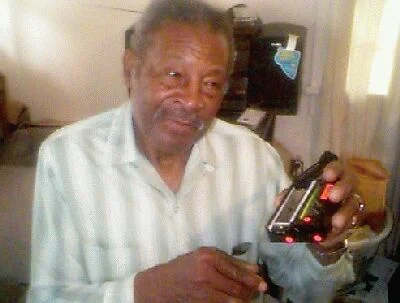











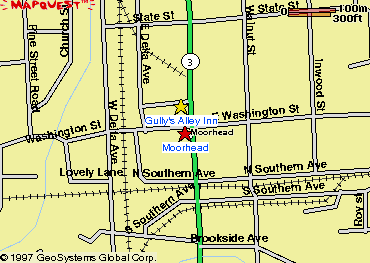











.jpg)
.jpg)




